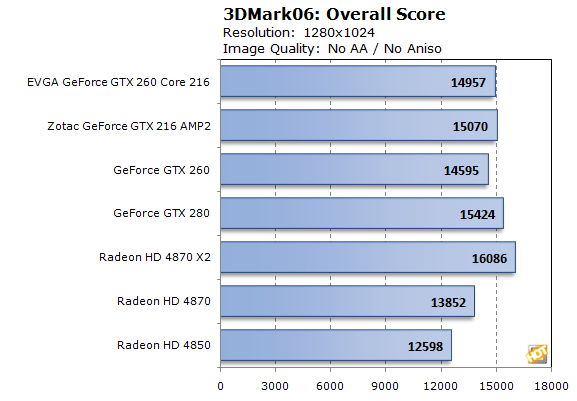NVIDIA GeForce GTX 260 Core 216: EVGA, Zotac
HOW WE CONFIGURED THE TEST SYSTEMS: We tested all of the graphics cards used in this article on either an Asus nForce 790i SLI Ultra based Striker II Extreme motherboard (NVIDIA GPUs) or an X48 based Asus P5E3 Premium (ATI GPUs) powered by a Core 2 Extreme QX6850 quad-core processor and 2GB of low-latency Corsair RAM. The first thing we did when configuring these test systems was enter their respective BIOSes and set all values to their "optimized" or "high performance" default settings. Then we manually configured the memory timings and disabled any integrated peripherals that wouldn't be put to use. The hard drive was then formatted, and Windows Vista Ultimate was installed. When the installation was complete we fully updated the OS, and installed the latest DX10 redist and various hotfixes, along with the necessary drivers and applications.
|
|
|
|
Asus Striker II Extreme Asus P5E3 Premium Radeon HD 4850 (2) Integrated Audio |
Relevant Software: Windows Vista Ultimate SP1 DirectX June 2008 Redist NVIDIA Forceware v177.92 |
|
|
|
|
|
3DMark06 is a synthetic benchmark, designed to simulate DX9-class game titles. This version differs from the earlier 3Dmark05 in a number of ways, and includes not only Shader Model 2.0 tests, but Shader Model 3.0 and HDR tests as well. Some of the assets from 3DMark05 have been re-used, but the scenes are now rendered with much more geometric detail and the shader complexity is vastly increased. Max shader length in 3DMark05 was 96 instructions, while 3DMark06 ups that number to 512. 3DMark06 also employs much more lighting and there is extensive use of soft shadows. With 3DMark06, Futuremark has also updated how the final score is tabulated. In this latest version of the benchmark, SM 2.0 and HDR / SM3.0 tests are weighted and the CPU score is factored into the final tally as well. |



Considering their clock speed differences (the Zotac GeForce GTX 260 AMP^2 Edition is clocked slightly higher than EVGA's offering), the new GeForce GTX 260 Core 216 cards performed just as expected--slightly ahead of the first-gen GTX 260, but just behind the high-end GTX 280. And the increased horsepower gives the Core 216 cards a larger edge over the Radeon HD 4870.



The same hold true in the multi-GPU SLI vs. CrossFire match up, with one notable exception. The GTX 260 Core 216 cards once again fall somewhere in between the first-gen GTX 260 and GTX 280, but superior scaling on the part of the Radeon HD 4870 cards give them the edge in the multi-GPU configuration in this benchmark.








